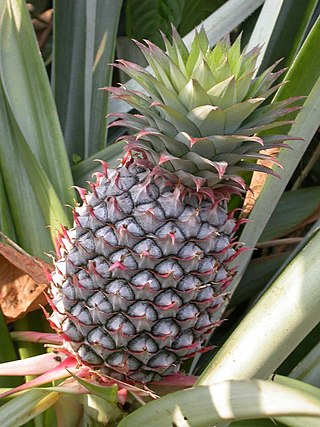
The Bromeliaceae are a family of monocot flowering plants of about 80 genera and 3700 known species, native mainly to the tropical Americas, with several species found in the American subtropics and one in tropical west Africa, Pitcairnia feliciana.

Tillandsia is a genus of around 650 species of evergreen, perennial flowering plants in the family Bromeliaceae, native to the forests, mountains and deserts of the Neotropics, from northern Mexico and the southeastern United States to Mesoamerica and the Caribbean to central Argentina. Their leaves, more or less silvery in color, are covered with specialized cells (trichomes) capable of rapidly absorbing water that gathers on them.
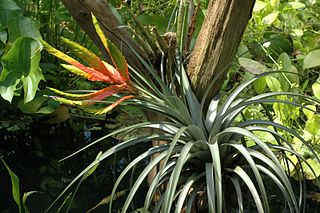
Tillandsioideae is a subfamily of plants in the bromeliad family Bromeliaceae. This subfamily contains the greatest number of species. Most are epiphytic or lithophytic, growing in trees or on rocks where they absorb water and nutrients from the air. Spanish moss of the genus Tillandsia is a well-known species. Bromeliads in the genera Guzmania and Vriesea are the more commonly cultivated members of this subfamily.
Gregbrownia brownii, synonym Mezobromelia brownii, is a species of flowering plant in the family Bromeliaceae. It is endemic to Ecuador. Its natural habitats are subtropical or tropical moist montane forests and subtropical or tropical high-altitude shrubland. It is threatened by habitat loss.

Gregbrownia fulgens, synonym Mezobromelia fulgens, is a species of flowering plant in the family Bromeliaceae. It is endemic to Ecuador. It grows in the páramo and high-elevation forest of the Andes. It is terrestrial or grows as an epiphyte.
Pseudaraeococcus chlorocarpus is a species of flowering plant in the family Bromeliaceae, native to Brazil. It was first described in 1862 as Lamprococcus chlorocarpus.
Quesnelia augustocoburgii is a species of flowering plant in the family Bromeliaceae, endemic to Brazil. It was first described by Heinrich Wawra von Fernsee in 1880. It is found in the Atlantic Forest ecoregion of southeastern Brazil. The name is sometimes spelt with a hyphen as Quesnelia augusto-coburgii.
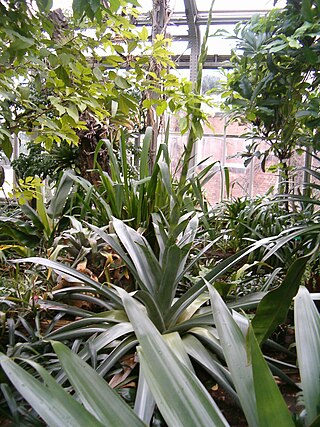
Pseudalcantarea grandis, synonym Tillandsia grandis, is a species of flowering plant in the family Bromeliaceae. This species is native to Mexico, Guatemala, and Honduras.
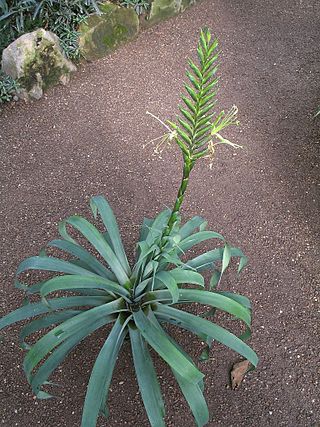
Pseudalcantarea viridiflora is a species of flowering plant in the family Bromeliaceae, native to Mexico and Central America. It was first described by Johann Georg Beer in 1856.
Gregbrownia lyman-smithii is a species of flowering plant in the family Bromeliaceae, native to Ecuador. It was first described in 1976 as Mezobromelia lyman-smithii.
Josemania truncata is a species of flowering plant in the family Bromeliaceae, native to Colombia and Ecuador. It was first described by Lyman Bradford Smith in 1954 as Tillandsia truncata. Plants of the World Online sinks the genus Josemania into Cipuropsis, treating this species as Cipuropsis truncata.
Cipuropsis is a genus of flowering plant in the family Bromeliaceae, native to the Caribbean, southern Central America and northwestern South America. The genus was first described by Ule in 1907.

Stigmatodon is a genus of plants in the family Bromeliaceae. It is endemic to Brazil.
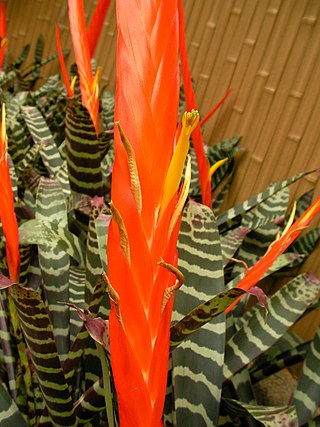
Lutheria is a genus of plants in the family Bromeliaceae. It is native to northern South America.

Lukas Bärfuss is a Swiss writer and playwright who writes in German. He won the Georg Büchner Prize in 2019.
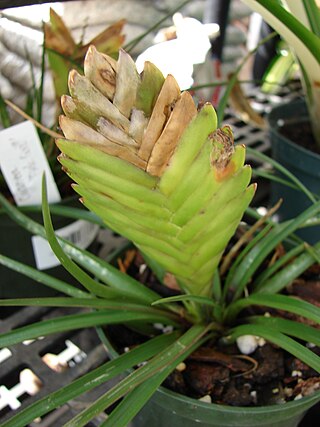
Wallisia is a genus of flowering plants belonging to the family Bromeliaceae. It is also in the Tillandsioideae subfamily.

Pseudalcantarea is a genus of flowering plants belonging to the family Bromeliaceae. Its native range is Mexico to Central America. It was first described as the subgenus Pseudalcantarea of Tillandsia before being raised to a full genus in 2016.
Josemania is a genus of flowering plant in the family Bromeliaceae, first described in 2016.
Gregbrownia hutchisonii is a species of flowering plant in the family Bromeliaceae, native to northern Peru. It was first described by Lyman Bradford Smith in 1966 as Tillandsia hutchisonii.










